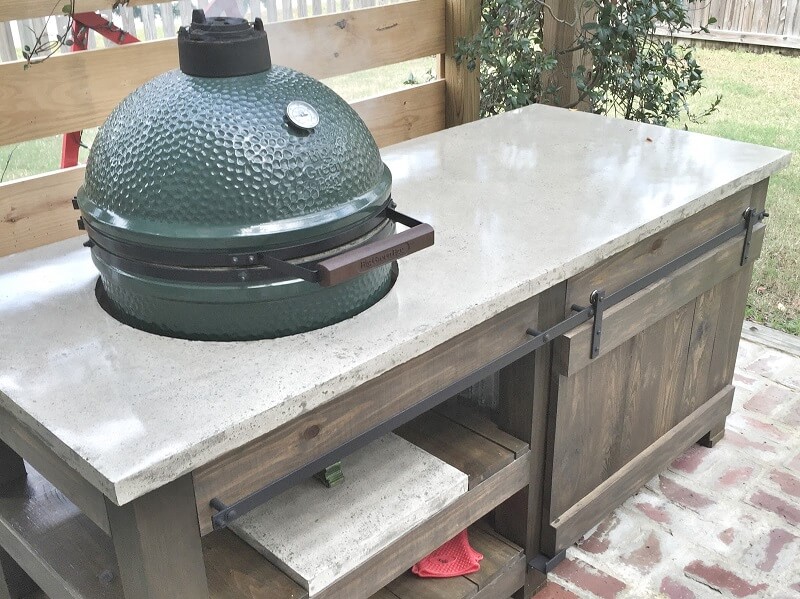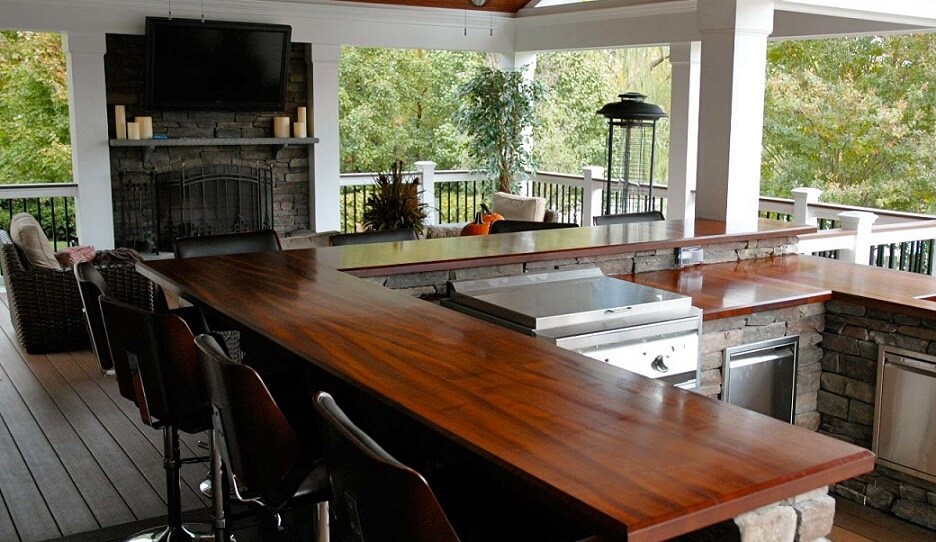How do you plan an outdoor kitchen?
Outdoor kitchen designs come in all shapes and sizes.
If you’re thinking about adding one to your home, the first thing is to figure out how much room you have and how much room you want to use.
Think about how you’re going to use your outdoor kitchen.
Will you host dinner parties with large groups? Or will you mostly be preparing dinner for the family?
The way you use your kitchen will determine which cooking appliances you include in your plans.
Most outdoor kitchens have a grill. Pizza ovens and smokers are also common, as are extra side burners. You can also include a sink, a refrigerator, or even a full bar.

If any part of the process seems like it’s beyond your skill level, consider engaging the expertise of a licensed contractor. Doubly so if you’re planning extensive design and construction work.
Selecting a location for your kitchen
Outdoor kitchens are typically located at the rear of the house, on the deck or patio.
Situate your outdoor kitchen close to your indoor kitchen. This setup cuts down on the hassle of ferrying food and equipment between the two.
Your kitchen also needs access to utilities: gas, electricity, and plumbing (if you want a sink). Extending utility hookups over long distances gets expensive. The closer your kitchen is to existing utilities, the better.

Also consider sunlight and wind, though you don’t have much control over them. You can always build additional protection as part of your design – more on that later in the article.
Creating the layout of your kitchen
With the location scouted out, the next step is to decide where everything’s going to go.
Start by finding places for the largest items – like the grill, countertops, or pizza oven – and work your way down to the smaller ones.
This is the time to do in-depth research on grills and other major appliances. You need to know which ones you’re buying and how much space they’ll take up. Then, you can design your counter and storage spaces to accommodate them.

With your plan drawn up, you can mark out the future positions of counters and appliances with tape. That will help you visualize what it’ll look like before you start building anything.
Don’t forget to include a dining area as part of your plan. It’d be a shame to invest a bunch of time and money into cooking outdoors and find yourself stuck eating inside.
We’ll get into dining areas a bit further down.
Try to give your outdoor kitchen at least partial shelter. Nothing ruins a cookout like wind and rain. Shelter can come from the adjacent walls of the house or a detached structure like a pergola.
What should you put in your outdoor kitchen?
As a minimum, an outdoor kitchen includes a grill and some counter space for prep work. Anything less than that, and it’s not really a kitchen.
You can make your design as lavish or as simple as you wish. Here are a few ideas for your outdoor kitchen plans:
Outdoor kitchen countertop ideas
The main thing that turns a patio grill into an outdoor kitchen is counter space.
Much like indoor kitchens, outdoor kitchens have many countertop options available.

Outdoor countertops are exposed to the elements. Inferior artisanship just isn’t going to cut it here.
Try to buy an outdoor-specific material for your countertops. If you can’t, consult with the manufacturer to be sure your counters will stand up to the outdoor environment.
Here are a few ideas for countertops to consider:
Stone
Not all types of stone are made equal. Marble is popular for indoor kitchens, but it doesn’t hold up well outside. Soapstone is a better choice for outdoor counters, as it’s highly resistant to heat and staining. It scratches easily, though.
Granite is the way to go if you want stone countertops outdoors. Granite stands up to the elements and resists food stains well.

Concrete
Consider concrete countertops if you’re going for a rugged look. They’re tough, and you can pour the concrete yourself if you’re DIY-ing the project. The downside? Concrete is prone to cracking if it’s not installed properly (and sometimes even if it is).

Tile
Tile countertops are easy to install and come in an endless variety of styles. If you live in a cold climate, though, be careful. The tiles and grouting are susceptible to cracking during seasonal freeze-thaw cycles. Choose cold-resistant materials or hire an experienced contractor to build your countertop for you.

Porcelain
Porcelain is durable and low maintenance. Plus, it’s UV-resistant, so it won’t get damaged by direct sunlight. It might be hard to find a fabricator for a porcelain slab countertop. You can use porcelain tiles instead, but make sure they’re installed properly.

Wood
Wood (aka butcher block) countertops look great, but they’re high maintenance. Wood countertops need to be protected from the weather and refinished often. Think of what happens to a wooden fence as it sits outside; you don’t want a countertop in similar condition.

Stainless steel
An unorthodox choice, but stainless steel is among the lowest of the low-maintenance options. The downside is that it conducts a lot of heat and throws glare if it’s sitting in direct sunlight.

Regardless of which type you choose, it’s wise to buy outdoor kitchen covers. You can get custom covers fabricated that match the size and shape of your counters and appliances. Or, you can search for off-the-shelf options to save money.
Keeping your outdoor kitchen covered when you’re not using it will help prolong its lifespan.
Outdoor kitchen backsplash ideas
Depending on your outdoor kitchen design, you may or may not have a backsplash (the wall behind the stove or countertop).
Often, the backsplash is as simple as extending the countertop material up the wall behind it. It can also be an opportunity to inject some extra style into your design.
Here are a few ideas to get you started:
Tile
Whether glass, porcelain, or ceramic, a tile backsplash is a stylish choice. They’re waterproof, durable, and available in any style you need.

Stone tiles
Stone tiles work with many design themes. They’re sturdy and easy to clean, but also a bit pricey. Make sure they’re installed by an expert, or they’re prone to cracking during seasonal freeze cycles.

Brick
Bricks are strong, durable, and look great. Many outdoor kitchens use brick structures as the foundation for heavy built-in grills or pizza ovens. It’s easy to extend the bricks upward and turn them into a stylish backsplash.

Corrugated metal
It won’t mix with just any style, but corrugated metal has its place. It’s cheap, indestructible, and easy to install.

Outdoor kitchen island ideas
Indoors, the kitchen island is a luxury for people with plenty of space. Not so with the outdoor kitchen, which isn’t constrained by walls.
Some outdoor kitchens only have islands! A grill and a little counter space might all you need.

With the addition of some barstools, an island also makes a great place to seat guests.

Whatever you decide to use your outdoor kitchen island for, make sure you leave enough room around the outside to walk around it comfortably.
If your outdoor kitchen doesn’t have enough room for a permanent island, you can include a portable one.
Outdoor kitchen grill ideas
Barbecues come in two essential forms: stand-alone and built-in.
Most grills used in outdoor kitchens are of the latter type. A grill that’s built into the counter space makes it feel more like an actual kitchen. Otherwise, it’s just a barbecue sitting on a deck (which is still nice, but not what we’re going for here).

There are countless makes and models of built-in grills. Spend some time researching and visiting stores or showrooms before you make the big decision. After all, the grill is the centrepiece of almost any outdoor kitchen.
Keep in mind the size of grill you’ll need. It will depend on how much room your outdoor kitchen has, and how many people you typically barbecue for. People often overbuy their grills; be realistic about how much cooking surface area you need.
Many people struggle with which type of grate they should have on their grill. Stainless steel? Porcelain-coated? Cast iron?
Each has different pros and cons. Many avid grillers prefer heavy cast-iron grates for their heat retention. Stainless-steel grills are effective and low-maintenance. Porcelain-coated grates work well, but the coating can chip if you use metal utensils.






















